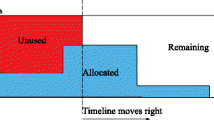Abstract
With the rapid development of the mobile computing, accessing the Internet everywhere is important for mobile device users. Wireless LAN is a stable and reliable technique to provide network access for mobile devices. The Wireless LAN Access Points(APs) have been densely deployed so that a user can access the Internet almost everywhere. However, this fact brings some new challenges. Since the regular AP association strategy is signal-based when a user receive the signals of multiple APs. The APs with strong signal will be too overloaded while the bandwidth resource in other APs is wasted. The throughput of the whole WLAN is not optimized. Moreover, the diverse bandwidth demands among users further exacerbate the situation. In this paper, aiming at optimizing the throughput over the whole WLAN, a joint AP association and bandwidth allocation problem is formulated. The different users’ bandwidth demands are added as new constraints. We comprehensively analyze the solution space and prove the problem NP-hard. Our trace-driven evaluations show that the throughput is improved about 23.1 % compared to the conventional schemes.





Similar content being viewed by others
References
Abusubaih M, Wolisz A (2007) An optimal station association policy for multi-rate ieee 802.11 wireless lans. In: MSWiM. ACM, pp 117–123
Akella A, Judd G, Seshan S, Steenkiste P (2007) Self-management in chaotic wireless deployments. Wirel Netw 13(6):737–755
Ala-Laurila J, Mikkonen J, Rinnemaa J (2001) Wireless lan access network architecture for mobile operators. IEEE Commun Mag 39(11):82–89
Bejerano Y, Han S-J (2009) Cell breathing techniques for load balancing in wireless lans. IEEE Trans Mob Comput (TMC) 8(6):735–749
Bejerano Y, Han S-J, Li LE (2004) Fairness and load balancing in wireless lans using association control. In: MOBICOM. ACM, pp 315–329
Boyd S, Vandenberghe L (2009) Convex optimization. Cambridge University Press, Cambridge
Chen L (2010) A distributed access point selection algorithm based on no-regret learning for wireless access networks. In: VTC. IEEE, pp 1–5
Chen X, Yuan W, Cheng W, Liu W, Leung H (2013) Access point selection under qos requirements in variable channel-width wlans. IEEE Wireless Commun Lett 2(1):114–117
Chen X, Zhao Y, Peck B, Qiao D (2012) Sap: smart access point with seamless load balancing multiple interfaces. In: INFOCOM. IEEE, pp 1458–1466
Chen Z, Xiong Q, Liu Y, Huang C (2014) A strategy for differentiated access service selection based on application in wlans. In: INFOCOM WKSHPS. IEEE, pp 317–322
Cui Y, Li W, Cheng X (2011) Partially overlapping channel assignment based on node orthogonality for 802.11 wireless networks. In: INFOCOM. IEEE, pp 361–365
Dandapat SK, Mitra B, Choudhury RR, Ganguly N (2012) Smart association control in wireless mobile environment using max-flow. IEEE Trans Netw Serv Manag (TNSM) 9(1):73–86
Du L, Bai Y, Chen L (2007) Access point selection strategy for large-scale wireless local area networks. In: WCNC, pp 2161–2166
Garey MR, Johnson DS (1979), Computers and intractability: An introduction to the theory of np-completeness
Ge W, Ji H, Leung V C, Si P (2011) Access point selection for wlans with cognitive radio: a restless bandit approach. In: ICC. IEEE, pp 1–5
Gong D, Yang Y (2012) Ap association in 802.11 n wlans with heterogeneous clients. In: INFOCOM. IEEE, pp 1440–1448
Gong H, Kim J (2008) Dynamic load balancing through association control of mobile users in wifi networks. IEEE Trans Consum Electron 54(2):342–348
Jain R, Chiu D-M, Hawe WR (1984) A quantitative measure of fairness and discrimination for resource allocation in shared computer system. Eastern Research Laboratory, Digital Equipment Corporation, Hudson
Karimi OB, Liu J, Rexford J (2014) Optimal collaborative access point association in wireless networks. In: INFOCOM. IEEE, pp 1141–1149
Kauffmann B, Baccelli F, Chaintreau A, Mhatre V, Papagiannaki K, Diot C (2007) Self organization of interfering 802.11 wireless access networks. In: INFOCOM. ACM, p 2005
Kelly F (1997) Charging and rate control for elastic traffic. Eur Trans Telecommun 8:33–37
Keranidis S, Korakis T, Koutsopoulos I, Tassiulas L (2011) Contention and traffic load-aware association in ieee 802.11 wlans: Algorithms and implementation. In: WiOpt. IEEE, pp 334–341
Li L, Pal M, Yang YR (2008) Proportional fairness in multi-rate wireless lans. In: INFOCOM. IEEE
Li W, Cui Y, Cheng X, Al-Rodhaan MA, Al-Dhelaan A (2011) Achieving proportional fairness via ap power control in multi-rate wlans. IEEE Trans Wirel Commun (TWC) 10(11):3784–3792
Li W, Wang S, Cui Y, Cheng X, Xin R, Al-Rodhaan M, Al-Dhelaan A (2014) Ap association for proportional fairness in multirate wlans. IEEE/ACM Trans Networking (TON) 22(1):191–202
Lu M, Wu J (2011) Localized access point selection in infrastructure wireless lans with performance guarantee. Wirel Commun Mob Comput 11(8):994–1010
Viterbi AJ, et al. (1995) CDMA: principles of spread spectrum communication, vol 129. Addison-Wesley, Reading
Xie L, Li Q, Mao W, Wu J, Chen D (2009) Achieving efficiency and fairness for association control in vehicular networks. In: ICNP. IEEE, pp 324–333
Xu F, Tan CC, Li Q, Yan G, Wu J (2010) Designing a practical access point association protocol. In: INFOCOM. IEEE, pp 1–9
Xu F, Zhu X, Tan CC, Li Q, Yan G, Wu J (2013) SmartAssoc: Decentralized access point selection algorithm to improve throughput. IEEE Trans Parallel Distrib Syst 24.12:2482–2491
Xue G, He Q, Zhu H, He T, Liu Y (2013) Sociality-aware access point selection in enterprise wireless lans. IEEE Trans Parallel Distrib Syst (TPDS) 24(10):2069–2078
Yen L-H, Li J-J, Lin C-M (2011) Stability and fairness of ap selection games in ieee 802.11 access networks. IEEE Trans Veh Technol 60(3):1150–1160
Acknowledgments
Supported by National Natural Science Foundation of China (no. 61422206, 61120106008), National 863 project (no. 2015AA015701), and the Academy of Finland (no. 278207).
Author information
Authors and Affiliations
Corresponding author
Rights and permissions
About this article
Cite this article
Tang, H., Yang, L., Dong, J. et al. Throughput Optimization via Association Control in Wireless LANs. Mobile Netw Appl 21, 453–466 (2016). https://doi.org/10.1007/s11036-015-0650-z
Published:
Issue Date:
DOI: https://doi.org/10.1007/s11036-015-0650-z




